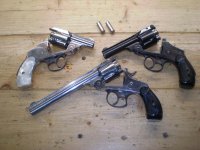Proprietary cartridges were very common prior to WW2. Major firearms manufacturers produced firearms chambered for their own cartridge designs, and generally resisted offering competing cartridge chamberings. Basically, the gun makers were reluctant to advertise or admit that another company's cartridge design might be as good or better than their own proprietary designs. This also allowed some measure of locking up future sales of ammunition for the guns sold.
.38 S&W Special was developed as an improvement over the earlier .38 Long Colt, which was already in Army service and popular in civilian sales as well. Smith & Wesson inserted the "S&W" into the new cartridge designation as a means of distinguishing the new cartridge as a Smith & Wesson proprietary design (why give a competitor, Colt, any credit?).
Known far more commonly today as simply .38 Special, and standardized as such by SAAMI (the industry standard-setter since about 1960). In addition to the longer cartridge case and greater powder capacity, the .38 Special uses inside-lubricated bullets instead of the earlier heeled-base design with larger forward diameter and exposed waxy lubricant outside the case.
The .38 Colt (short and long) evolved with the earlier conversions of .36 caliber Colt percussion revolvers to cartridge guns, initially as rim-fire until center-fire cartridges became the norm. Those early revolvers typically had bore diameters of .36 caliber and rifling grooves of about .370-.375", so the heeled-bullet of larger diameter to provide better gas sealing when fired. The newer .38 Special with inside-lubed bullets allowed (demanded) a smaller bore & groove diameter for the bullet diameter that fit entirely within the cartridge case.
Confusing to many folks, but easy to understand when the period of cartridge arms development took place. Lots of different ideas and approaches, lots of poaching by manufacturers as they saw a competitor come to market with a useful development or improvement. During the same period many of the proprietary cartridges developed new nomenclature, allowing more makers to offer arms for popular calibers without crediting the original maker (.44 WCF became .44-40, .32 WCF became .32-20, .30 WCF became .30-30, and others as gun makers other than the original designers sold their own guns in other makers' cartridge designs).
Marketing ploys, horning in on older proprietary markets.
The original .38 Colt Center-Fire became the .38 Short Colt and .38 Long Colt, then evolved into the .38 Special, then to the .357 Magnum, and eventually to the .357 Maximum. All used the same case head, rim dimensions, case diameter, etc, beginning about 1872 and continuing on today.




